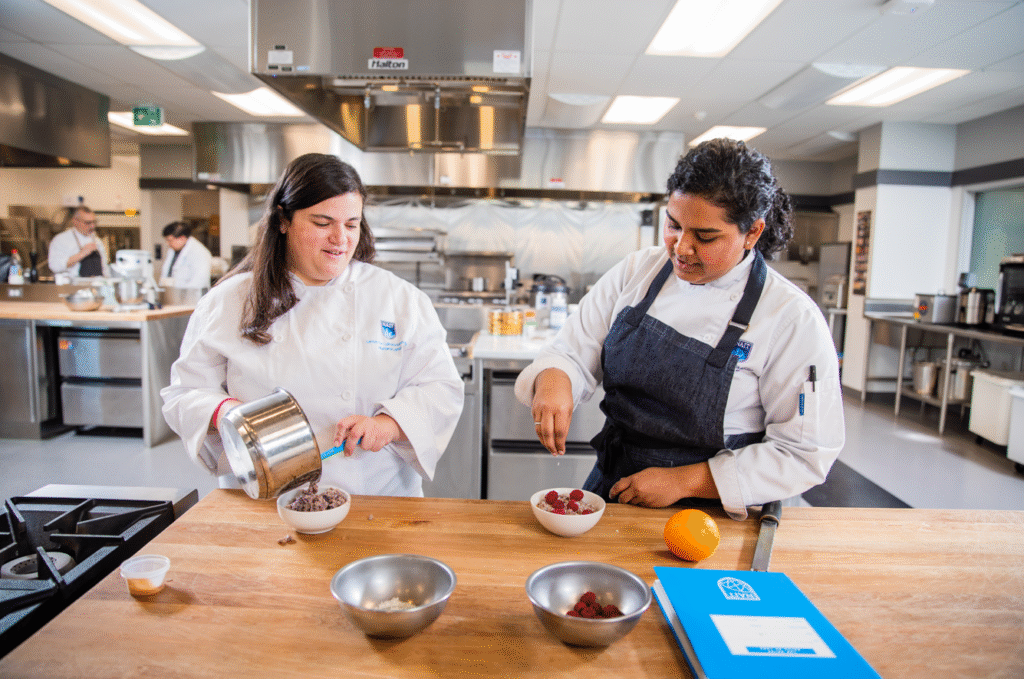By Andrew Heck

‘Innovation’ is a complicated word. While few can define it with absolute confidence, it doesn’t take a scientist to recognize it in our lives.
Nevertheless, the researchers at NAIT Applied Research are partnering with food manufacturers to create made-in-Alberta products, using local ingredients, that appeal to today’s increasingly diverse consumer tastes. And they’re doing it inside the Centre for Culinary Innovation by fundamentally transforming ordinary inputs – including pork – into value-added items that respond to modern demands.
“I love the psychology of food,” said Linda Ho, Applied Research Chair in Agri-Food Sustainability, NAIT. “Why do people consume what they consume? And for a product like pork, how can we get them to consume more of it?”
The Northern Alberta Institute of Technology (NAIT) is a trade- and technology-based polytechnic located in Edmonton. It offers a range of certificate, diploma and degree programs that prepare students for the workforce in many of the province’s key industries, including food and agriculture.
Ho’s professional experience includes a balance of academic and private-sector positions, including a background in meat microbiology. Since joining NAIT in 2022, she has led the Centre for Culinary Innovation alongside a rotation of student helpers and fellow food scientist Christopher Song.
“People come to us and say, ‘My grandma’s sauce is so amazing, and I want to scale it up and sell it,’” said Ho. “Most often, these recipes are ‘a little of this, a little of that,’ but we help quantify the ingredients in a precise way.”
While everyone knows that love is the real secret ingredient in grandma’s sauce, food chemistry plays an important role in product creation. And at the intersection of art and science – where creativity meets commercialization – is where you’ll find the NAIT research team working hard to deliver results for budding entrepreneurs.
Research kitchen provides the platform

NAIT’s 2,000-square-foot research kitchen is a fully customizable space for bench-top food and beverage product development, characterization of new food ingredients and recipe development. It features 12 dedicated food-prep stations, along with equipment like a meat grinder, freeze dryer, thermocirculator (sous-vide machine), vacuum-packing devices and more.
While the Centre for Culinary Innovation is relatively new, the notion of a post-secondary food lab has deep roots in other places, such as the internationally renowned Wageningen University in the Netherlands, where value-added food processing exports contribute significantly to the country’s GDP. In fact, the Netherlands is ranked second globally in food and agriculture exports. Canada, by contrast, historically, has opted to export raw materials, including pork primals. While that reality is unlikely to change, Ho thinks that manufacturers and the industry at large would benefit from pursuing ideas that add value to products. And NAIT is poised to support the transition.
“We are building the same ecosystem here,” said Ho. “It’s readily available – just whether innovators want to tap into it.”
Since opening in 2019, the centre has helped dozens of clients take their ideas from concept to creation. After completing their projects, clients retain the intellectual property. This type of business ‘incubation’ is one of NAIT’s strengths and has ample appetite across Canada.
Recently, the centre began working on a project with Alberta Pulse Growers to experiment with miso: a fermented paste typically made from soybeans, common in Japanese cuisine.
“Alberta doesn’t really have soybeans,” said Ho. “But we do have plenty of other crops that can work for this purpose.”
Using pastes from Alberta crops like chickpeas, field peas and faba beans, naturally occurring bacteria consume the carbohydrates found in these ingredients, creating enzymes that break down the proteins. The results, given the experimental nature of the process, can create unique and unexpected flavours.
“We did a test with consumers and found that they were tasting notes of strawberry and chocolate,” said Ho. “That’s really interesting, because we didn’t predict that, and these flavours are difficult to replicate without actual strawberries and chocolate.”
While strawberries and chocolate aren’t the concern of hog producers or pork processors, the experiment highlights some opportunities for the sector. Notably, Ho believes that some of the compounds being created in the miso-like mixture could speed up the process of wet-aging – a technique that involves vacuum-sealing and refrigerating pieces of meat for several days or even weeks. The technique relies on enzymes to tenderize tough cuts and concentrate flavours. Using these cuts not only eliminates food waste, but it represents sustainability for everyone in the value chain.
“Consumers today are looking for accessible proteins,” said Ho. “That’s true whether it’s pork or any protein.”
Shelf-stability, versatility and ease of preparation are having a heyday right now, as consumers increasingly seek out convenience products but still want to save money. Whether through wet-aging, further processing or through other means, pork stands out as an ideal candidate.
Pork provides value-added opportunities

With the recent announcement that Canadian pork exports to Japan have overtaken U.S. pork exports for the first time ever, Japan provides further insight into the possibilities for Canadian pork closer to home.
The Canadian pork industry is committed to the highest standards of food safety, animal care and environmental sustainability. Federally regulated feeding and processing facilities ensure consistency that Japanese buyers have come to expect. Canadian consumers, on the other hand, have potential for further education.
“Think about wagyu beef,” said Ho. “People love it, and they pay a lot for it. The product is a result of so much love and care for the animals.”
‘Wagyu’ refers to cattle raised in Japan that have been specially bred with high fat content and intense marbling. Authentic wagyu cuts can cost more than $300 per kilogram, at retail, and there is no shortage of North American imitators that have tried to get a piece of the action through further cross-breeding with domestic cattle. And while wagyu has gained widespread recognition and intrigue, pork really has no immediate equivalent – not because of a lack of quality, but a lack of appreciation.
“Pig breeding has come a long way, and the genetics and handling of animals today creates less stress and allows for better pork,” said Ho. “By introducing consumers to new ways of cooking and eating, though innovation, we can show that it’s possible to cook pork to a lower finished temperature, for example, which preserves flavour.”
The current tariff-challenged business environment also underscores the importance of Canadian collaboration. As provinces express renewed interest in supporting interprovincial trade, businesses could take advantage of selling products with national reach.
Additionally, while consumers themselves are often implicated for a lack of knowledge, producers, too, are encouraged to consider the bigger picture.
“Farmers are focused on growing pigs, which makes sense, but what about the end product?” said Ho. “Ultimately, farmers produce food – not just animals – and it’s important to think about what that means. How do you balance growth performance and meat quality?”
Research provides the pathway

The journey from farm to fork is a long one – not so different from taking an idea and seeing it come to fruition, through research. On a day-to-day basis, hog producers and pork consumers seldom have the chance to connect with each other. For consumers, interacting with pork in the restaurant, grocery store and at home – and its value-added products – is what stands out.
Canadian pork value chain partners should consider what research can do to benefit business. Be it pork- or plant-based product development, NAIT’s Centre for Culinary Innovation has attracted entrepreneurs from all walks of life who are trying to cater to underserved demographics, to achieve results that attract sales. That’s a potential win for everyone, from producers and processors to retailers and consumers.






